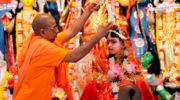Probashbangla24 online Desk : In Birendra Krishna Bhadra’s famous rendition of Mahishasura-mardini on Mahalaya, which signals the arrival of Ma Durga and Pujo in most Bengali households across the world, there is a segment that describes the creation of Durga to save the gods and the world from the demon king, Mahishasura.
‘Apurbo stri murti mahashakti debogoner angsho sambhuta; Debogoner samossthibhuto tyegopindo ak borobornini saktiswarupini debi murti dharon korle,’ Bhadra recites, describing Devi Durga’s creation from the combined divine energies of the Trimurti—Shiva, Vishnu and Brahma. Taking the form of ‘dashabhuja’, or the 10-armed goddess, Durga was bestowed with ornaments, clothes and weapons such as the Chakra, Shankha, Trishula, Gada, Bow, Arrow, Sword, Shield and Bell by the many gods, as they sang her glory and requested her to deliver them from the atrocities of Mahishasura.
While this story explains the creation of Goddess Durga from a mythological perspective, it is also interesting to look into how this image came to be represented in a physical form: The clay idol that—with just slight exaggeration in sentiment—becomes the focal-point of the lives of Bengalis, world-wide, for three-to-five days of the Sharodiya Durga Puja. So called because it is held in the latter part of the year, during September and October. However, preparations for the Pujo as well as the sculpting of the idols actually start months in advance, reports The Statesman.
THE FRAMEWORK
Think about the making of Durga idols, or protima as they’re called in Bengali, and images of countless rows of semi-finished idols placed across the narrow bylanes of Kolkata’s Kumortuli area immediately come to mind. Kumortuli is the city’s biggest hub of clay image making, which has played host to generations after generations of kumors (potters) and mritshilpis (clay sculptors).
While some of the rituals have been sacrificed at the altars of time and convenience, the art and process of idol-making has largely remained unchanged since the 16th and 17th centuries—which is when Durga Pujas transformed from simple home pujas to the large-scale festival we see now.
The sculptors usually start the process of making the protimas with Pata Puja on the day of the Rath Yatra (usually in July). “Pata refers to the basic wooden frame in which the idols are made,” says Biswajit Pal, a veteran mritshilpi from Krishnanagar, West Bengal. “Some also perform this puja during Janamshtami,” he adds, emphasizing that both days are auspicious.
The first stage of the process involves the creation of a bamboo frame for all the seven figures (Durga, her lion, Mahishasura, Saraswati and her swan, Lakshmi and her owl, Ganesha and his mouse, and Kartik and his peacock). This skeletal frame is filled with khar (hay) to give volume, which also ensures that the idols are not too heavy.
EARTH FROM A PROSTITUTE’S HOUSE, AND MORE
“There is the curious ritual of including in this alluvial clay a lump of earth scooped from the threshold of a prostitute’s house, to sanctify in the process both the soil and the tainted locality from which it is drawn,” writes Tapati Guha-Thakurta, in her seminal book ‘In the Name of the Goddess’. “[A] month ahead of the Pujas, sex workers sell soil to the clay modellers at prices ranging between Rs.10–20 for a bag,” she adds. Pal explains that the local Dashakarma stores (small shops where people can buy puja-related items) also keep these various soils for individual sculptors to use.
This is then mixed with clay from a river bank, which is usually Ganga in the case of Kumortuli, and whichever other material that can be locally sourced. Sometimes, as many as seven types of clay are mixed to make the final paste. Pal says, “When we are away from any water body, or go abroad, we make use of whatever soil is locally available.” However, there is one type of clay—a smoother-softer variety—that some of them prefer to carry with them, since that’s used to make the face, hands and other intricate embellishments.
After the hay filling, there comes a layer of thick sticky clay to give shape to the figures, explains Kolkata-based retired teacher Chandranath Banerjee, who has observed the process in close proximity over the decades. After this layer dries, another layer is clay is applied to carve the body. For the face and hands, jute fibres are meticulously kneaded into the clay to make it sturdy yet pliable. The special moulding clay forms the final coat. Most sculptors use moulds for the face and hands to maintain quality and uniformity. In some instances, when the artist is known for a particular style, he saves and uses this mould over many years.
Once the clay dries, the figures are covered in white “chalk paint and tamarind seed gum, which forms the binding for different colours in which they are painted, the adding on of the hair, clothing, ornaments and weapons to the figures, and the painting of the background frames supporting them. The process culminates in the painting of the eyes of the central figure of Durga, marking the symbolic bringing to life of the icon—a ritual [called Chokkhodaan] that is most effectively played out on the morning of Mahalaya”, writes Guha-Thakurta. An important element in the overall staging of the idols is the mandatory placing of Shiva above Durga’s head—either as a figure or a simple photograph also suffices. “After all, you can’t worship Durga without Shiva,” exclaims Pal.
THE POSTAL SERVICE CONNECTION
While in today’s era of theme pujas, this is no limit to the variety of decorations (called shaaj), traditionally, there have been three types, says Banerjee: Daak-er Shaaj, Shola-r Shaaj and Maati-r Shaaj. Daak-er Shaaj refers to the predominantly golden zari work used to decorate the idols. Interestingly, it gets its name from ‘daak’, or postal service, since the raw material would come by daak and, hence, Daak-er Shaaj. Shola-r Shaaj is the delicate and intricate decoration made using strips of the shola stem, while Maati-r Shaaj, possibly the oldest type and for which Krishnanagar is famous, consists of only clay embellishments, which includes the drapes, ornamentations and even flowing mane.
Another aspect of the idol being staged is the positioning. Under the traditional ‘ek-chala’ discipline, all the figures are placed under a single arch. Now, though, multiple arches are used and the positioning of the various are also aesthetically and creatively changed to match themes and preferences.
All ready, on Panchami/Sasthi, the idols are placed within the pandals, and the priests begin the puja of the idol by placing the brass vessel, symbolic of the Devi’s energy, in front of the idol. This is called ‘praan pratishtha’. And amid the blowing of conch shells, the clanging of bells, the recitations of mantras, the smoke from dhunuchis and the pulsating energy of millions of exciting devotees, Ma enters and transforms our lives for five days, when nothing other than pujo, pandal-hopping, bhog, new clothes and anushthaans matter.
So, the next time you visit a puja pandal, be sure to pay close attention to the craftsmanship that goes into making these gorgeous protimas. Shubho Pujo!






